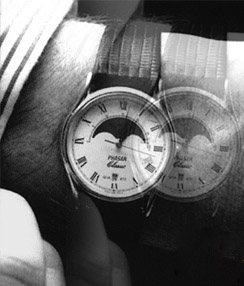
In biology, binocular vision is a type of vision in which an animal has two eyes capable of facing the same direction to perceive a single three-dimensional image of its surroundings. Binocular vision does not typically refer to vision where an animal has eyes on opposite sides of its head and shares no field of view between them, like in some animals.

Depth perception is the ability to perceive distance to objects in the world using the visual system and visual perception. It is a major factor in perceiving the world in three dimensions. Depth perception happens primarily due to stereopsis and accommodation of the eye.

The field of view (FoV) is the extent of the observable world that is seen at any given moment. In the case of optical instruments or sensors it is a solid angle through which a detector is sensitive to electromagnetic radiation.
The flicker fusion threshold, critical flicker frequency (CFF) or flicker fusion rate, is a concept in the psychophysics of vision. It is defined as the frequency at which an intermittent light stimulus appears to be completely steady to the average human observer. A traditional term for flicker fusion is "persistence of vision", but this has also been used to describe positive afterimages or motion blur. Although flicker can be detected for many waveforms representing time-variant fluctuations of intensity, it is conventionally, and most easily, studied in terms of sinusoidal modulation of intensity.

Amblyopia, also called lazy eye, is a disorder of sight in which the brain fails to fully process input from one eye and over time favors the other eye. It results in decreased vision in an eye that typically appears normal in other aspects. Amblyopia is the most common cause of decreased vision in a single eye among children and younger adults.

Visual acuity (VA) commonly refers to the clarity of vision, but technically rates a person's ability to recognize small details with precision. Visual acuity depends on optical and neural factors. Optical factors of the eye influence the sharpness of an image on its retina. Neural factors include the health and functioning of the retina, of the neural pathways to the brain, and of the interpretative faculty of the brain.

Diplopia is the simultaneous perception of two images of a single object that may be displaced horizontally or vertically in relation to each other. Also called double vision, it is a loss of visual focus under regular conditions, and is often voluntary. However, when occurring involuntarily, it results in impaired function of the extraocular muscles, where both eyes are still functional, but they cannot turn to target the desired object. Problems with these muscles may be due to mechanical problems, disorders of the neuromuscular junction, disorders of the cranial nerves that innervate the muscles, and occasionally disorders involving the supranuclear oculomotor pathways or ingestion of toxins.

Binocular rivalry is a phenomenon of visual perception in which perception alternates between different images presented to each eye.

The stroboscopic effect is a visual phenomenon caused by aliasing that occurs when continuous rotational or other cyclic motion is represented by a series of short or instantaneous samples at a sampling rate close to the period of the motion. It accounts for the "wagon-wheel effect", so-called because in video, spoked wheels sometimes appear to be turning backwards.
Stereopsis is the component of depth perception retrieved through binocular vision. Stereopsis is not the only contributor to depth perception, but it is a major one. Binocular vision happens because each eye receives a different image because they are in slightly different positions on one's head. These positional differences are referred to as "horizontal disparities" or, more generally, "binocular disparities". Disparities are processed in the visual cortex of the brain to yield depth perception. While binocular disparities are naturally present when viewing a real three-dimensional scene with two eyes, they can also be simulated by artificially presenting two different images separately to each eye using a method called stereoscopy. The perception of depth in such cases is also referred to as "stereoscopic depth".
Riccò's law, discovered by astronomer Annibale Riccò, is one of several laws that describe a human's ability to visually detect targets on a uniform background. This law explains the visual relationship between a target angular area A and target luminance increment required for detection when that target is unresolved. The law is given by:

Fixation disparity is a tendency of the eyes to drift in the direction of the heterophoria. While the heterophoria refers to a fusion-free vergence state, the fixation disparity refers to a small misalignment of the visual axes when both eyes are open in an observer with normal fusion and binocular vision. The misalignment may be vertical, horizontal or both. The misalignment is much smaller than that of strabismus. While strabismus prevents binocular vision, fixation disparity keeps binocular vision, however it may reduce a patient's level of stereopsis. A patient may or may not have fixation disparity and a patient may have a different fixation disparity at distance than near. Observers with a fixation disparity are more likely to report eye strain in demanding visual tasks; therefore, tests of fixation disparity belong to the diagnostic tools used by eye care professionals: remediation includes vision therapy, prism eye glasses, or visual ergonomics at the workplace.

Infant vision concerns the development of visual ability in human infants from birth through the first years of life. The aspects of human vision which develop following birth include visual acuity, tracking, color perception, depth perception, and object recognition.

Contrast is the contradiction in luminance or colour that makes an object distinguishable. In visual perception of the real world, contrast is determined by the difference in the colour and brightness of the object and other objects within the same field of view. The human visual system is more sensitive to contrast than absolute luminance; we can perceive the world similarly regardless of the huge changes in illumination over the day or from place to place. The maximum contrast of an image is the contrast ratio or dynamic range. Images with a contrast ratio close to their medium's maximum possible contrast ratio experience a conservation of contrast, wherein any increase in contrast in some parts of the image must necessarily result in a decrease in contrast elsewhere. Brightening an image will increase contrast in dark areas but decrease contrast in bright areas, while darkening the image will have the opposite effect. Bleach bypass destroys contrast in both the darkest and brightest parts of an image while enhancing luminance contrast in areas of intermediate brightness.
In humans, monocular vision is vision using only one eye, or using multiple eyes independently of each other. Depth perception in monocular vision is reduced compared to binocular vision, but still is active primarily due to accommodation of the eye and motion parallax. The word monocular comes from the Greek root, mono for single, and the Latin root, oculus for eye.
A perceptual paradox illustrates the failure of a theoretical prediction. Theories of perception are supposed to help a researcher predict what will be perceived when senses are stimulated.
Binocular disparity refers to the difference in image location of an object seen by the left and right eyes, resulting from the eyes’ horizontal separation (parallax). The brain uses binocular disparity to extract depth information from the two-dimensional retinal images in stereopsis. In computer vision, binocular disparity refers to the difference in coordinates of similar features within two stereo images.

Motion Induced Blindness (MIB) is a phenomenon of visual disappearance or perceptual illusions observed in the lab, in which stationary visual stimuli disappear as if erased in front of an observer's eyes when masked with a moving background. Most recent research has shown that microsaccades counteract disappearance but are neither necessary nor sufficient to account for MIB.

A peripheral head-mounted display ('PHMD) is avisual display mounted to the user's head that is in the peripheral of the user's field of view (FOV) / peripheral vision. Whereby the actual position of the mounting is considered to be irrelevant as long as it does not cover the entire FOV. While a PHMD provide an additional, always-available visual output channel, it does not limit the user performing real world tasks.
Binocular switch suppression (BSS) is a technique to suppress usually salient images from an individual's awareness, a type of experimental manipulation used in visual perception and cognitive neuroscience. In BSS, two images of differing signal strengths are repetitively switched between the left and right eye at a constant rate of 1 Hertz. During this process of switching, the image of lower contrast and signal strength is perceptually suppressed for a period of time.




















